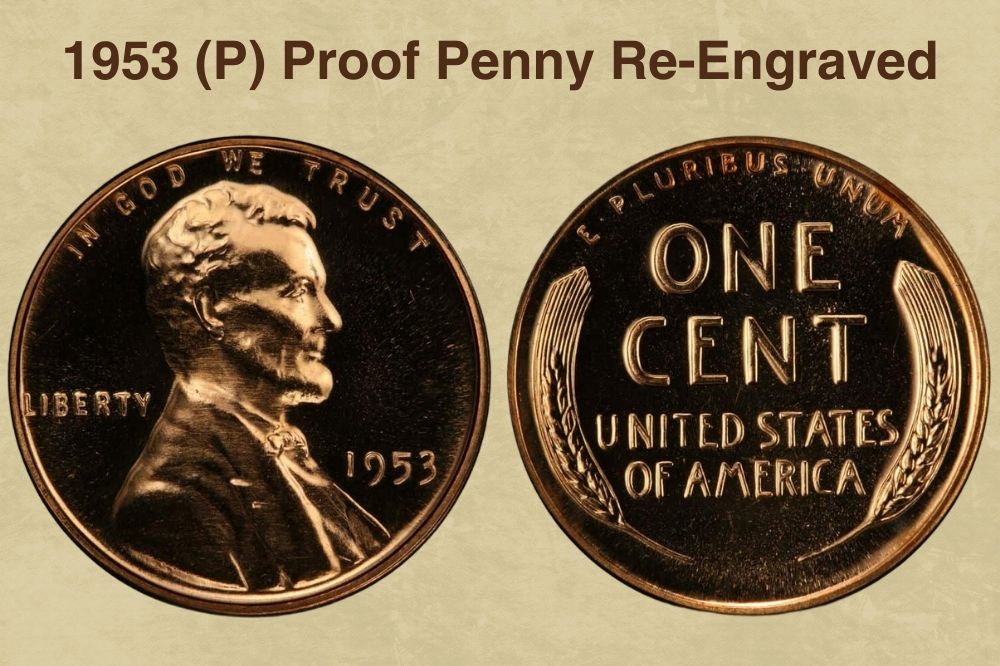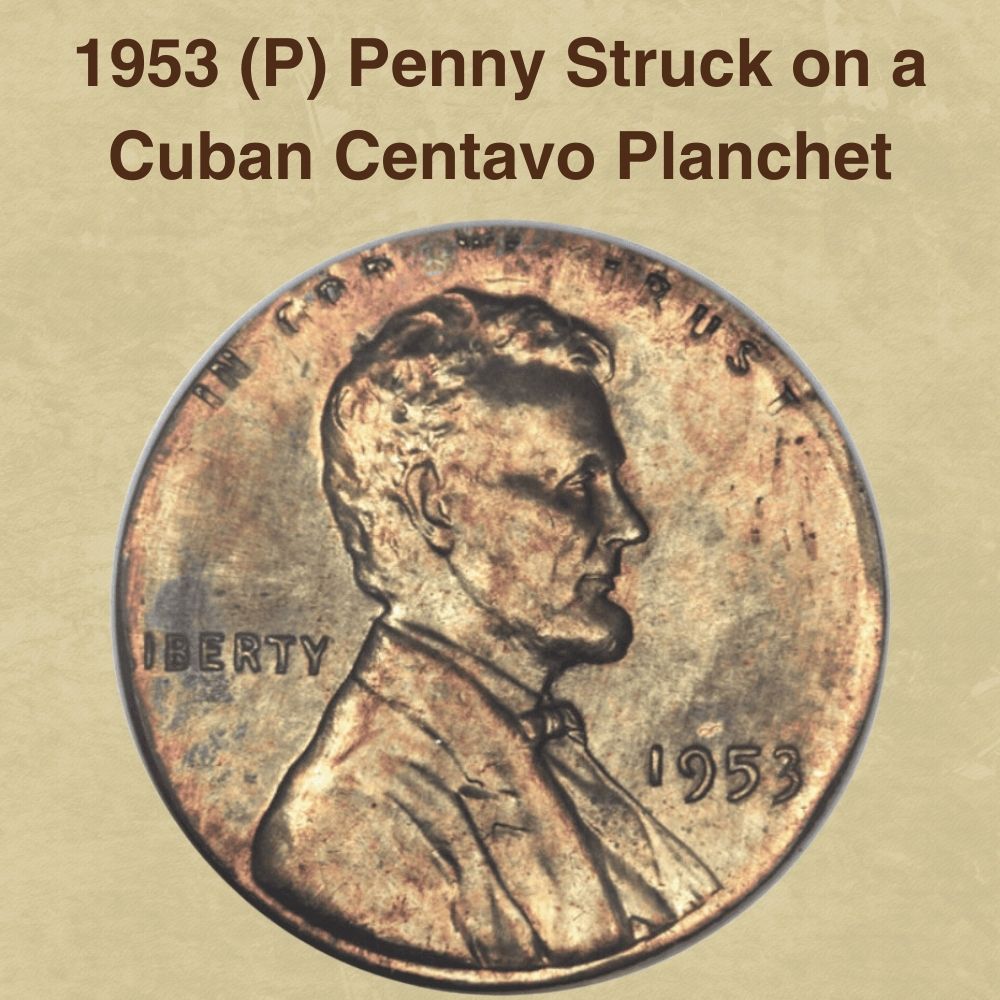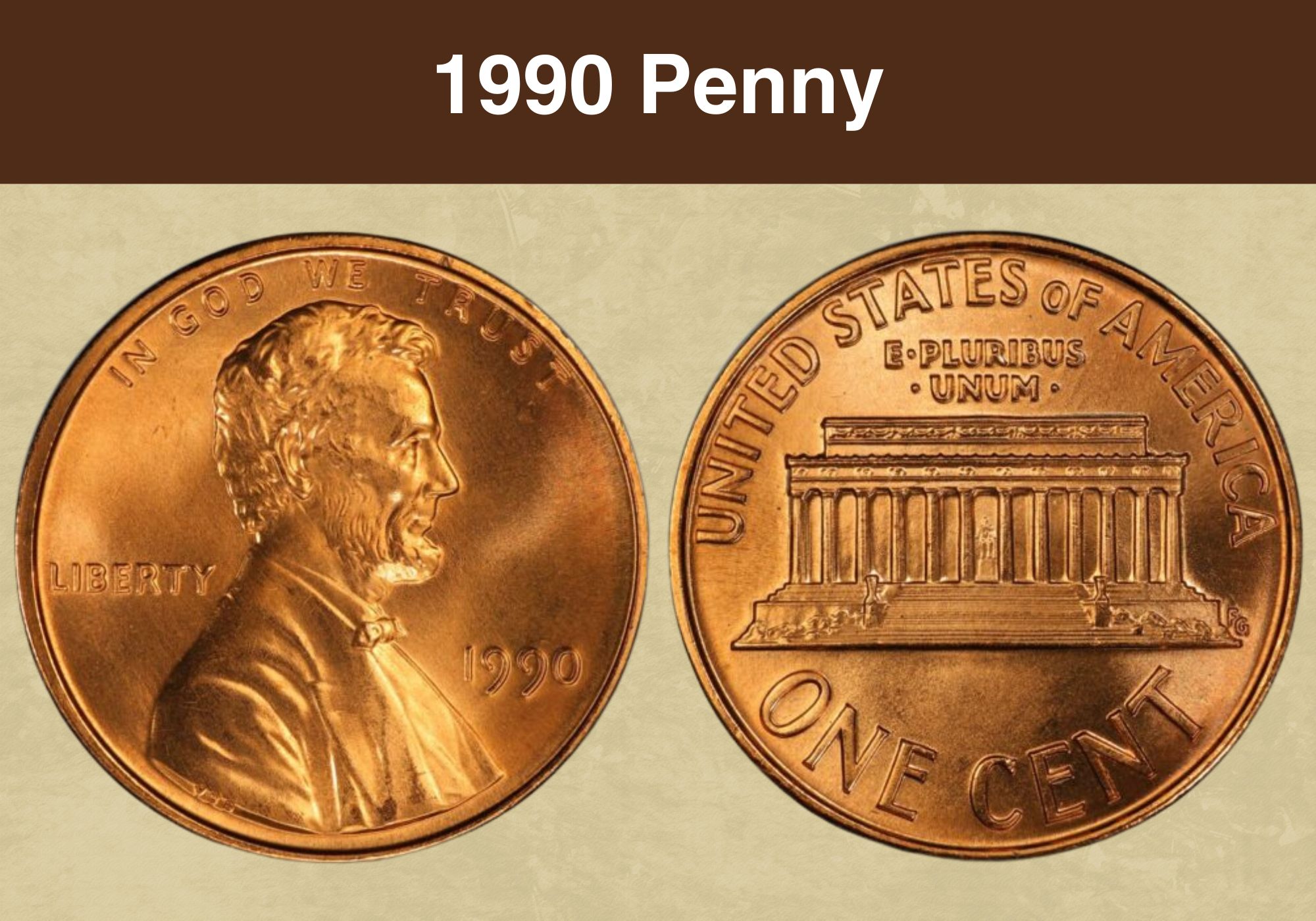
Coin Value Contents Table
- 1953 Wheat Penny Value Chart
- History of the 1953 Wheat Penny
- Features of the 1953 Wheat Penny
- 1953 Wheat Penny Grading
- 1953 Wheat Penny Value Guides
- 1953-D Wheat Penny Value
- 1953-S Wheat Penny Value
- 1953 No Mint Mark Wheat Penny Value
- 1953 (P) Proof No Mint Mark Wheat Penny Value
- Rare 1953 Wheat Penny Errors List
- Where to Sell Your 1953 Wheat penny ?
- 1953 Wheat Penny FAQ
The Wheat Penny was the third series of Small Cents after the Flying Eagle Cent and the Indian Head Cent. These Small Pennies were 19.05mm in diameter, as opposed to the earlier Large Cents that were 28.5mm in diameter. The reduction was caused by rising copper prices driven by the 1850s gold rush. But for now, we’re interested in the 1953 Wheat Penny Value.
1953 Wheat Penny Value Chart |
|||||||
| Coin | MS64+ RD | MS 65+ RD | MS66+ RD | MS 67 RD | MS 67+ RD | MS 68 RD | PR/PF 67+ DCAM |
| 1953-D Wheat Penny | $16 | $28 | $80 | $750 | $6,500 | – | – |
| 1953-S Wheat Penny | $16 | $28 | $50 | $225 | $1,300 | $19,500 | – |
| 1953 No Mint Mark Wheat Penny | $24 | $42 | $325 | $3,750 | $20,000 | – | – |
| 1953 (P) Proof No Mint Mark Wheat Penny | – | – | – | – | – | – | $11,000 |
History of the 1953 Wheat Penny
The Wheat Penny or Wheat Cent is the earliest version of the Lincoln Penny. It was launched in 1909 and six more would follow – namely the Memorial Penny in 1959, four Bicentennials in 2009, and the Shield Penny that we still use today. All seven featured Abraham Lincoln, the 16th US President, and the first one to appear on a circulating coin. But let’s go back a bit.
The idea for the Wheat Penny was seeded in 1904. Theodore Roosevelt – better known as Teddy – was the 26th US President. He wanted American coins to be prettier. Some agreed with him, including top numismatists and artists of the time. And they’d been pushing for new coins. These proponents included Augustus Saint-Gaudens and Richard Watson Gilder.
These two began to pester the US Mint in the 1880s, and in 1891, Saint-Gaudens and nine other artists were invited to join a coin design contest. But the Chief Mint Engraver, Charles Barber, seemed to deliberately set terms that the artists would shoot down. In the end, he did the new coins himself, and they came to be known as Barber Coinage. Fast-forward to 1904.
Redesigning the Small Cent
It turns out Saint-Gaudens and Teddy Roosevelt were friends, so when the President wanted US coins redone, he made the mint hire Saint-Gaudens. Sadly, the sculptor now had cancer. He made a new Eagle ($10 Gold) and Double Eagle ($20 Gold) before he passed away. They wanted him to do the penny as well, possibly because he did a Centennial Statue of Lincoln.
The Mint had already decided they wanted to put Lincoln on the Penny to celebrate 100 years since his birth, so it made sense to use Saint-Gaudens. But when he died in 1907 before completing the penny, one of his assistants stepped forward to finish the task. His name was Victor David Brenner, and he had just designed a Lincoln plaque for Gorham Manufacturing.
For the back of the coin, Brenner originally wanted to use tree branches styled like the ones on French Silver coins. But Mint Director Frank A. Leach spotted the similarity and asked for alternatives. Brenner settled on two ears of durum wheat, which is why we call it the Wheat Cent or Wheat Penny. The mint agreed since the stalks of wheat were much easier to carve.
The Legacy of the Wheat Penny
Saint-Gaudens had intended his Double Eagle design for his penny. And even as a $20 coin, it was a headache to produce, requiring three to eleven strikes per coin. That meant extra time and expense for the US Mint, so they were much happier with the simpler Lincoln Cent. It still caused problems, mostly due to spill-over feuds between Saint-Gaudens and Barber.
The clashes can be traced to their rivalry in 1891. Back then, they were trying to replace the Morgan Dollar and its contemporaries. But their differences in personalities, world view, and artistic vision made it an unpleasant experience for everyone. Still, the Wheat Cent prevailed. It proved popular enough to continue until 1958. And the 1953 Penny is one of its later dates.
The Mint had started talks to replace the Wheat Penny in 1952, so people in the know had an interest in 1953 coins. But the decision wasn’t finalized until December 1958 and the Lincoln Memorial Penny was set for production in January 1959, with its official release in February. The coin had two popular errors – DDOs and RPMs. We’ll discuss them in the Error Section.
Also read: 12 Most Valuable Lincoln Penny Worth Money
Features of the 1953 Wheat Penny
It can be helpful to describe coin features in numismatic terms. Consider referring to the heads side as the obverse, the tails side as the reverse, the thin side as the edge, the raised border as the rim or collar, the words on the coin as mottos or legends, the images on the coin as devices, and the background as the field. Blank coin discs are known as planchets.
The Obverse of the 1953 Wheat Penny
It shows Abraham Lincoln facing right. The motto In God We Trust floats over his head. The legend Liberty is behind him while the mint date and the mint mark are in front of him. On his portrait’s shoulder cut-off, VDB is engraved to mark coin designer, Victor David Brenner.
The Reverse of the 1953 Wheat Penny
It shows two stalks of durum wheat framing the wording on the coin. At the top of the coin, between the tips of the two wheat sheaves, it says E Pluribus Unum. Below that, it shows the coin denomination aka its face value, One Cent. Under that, it says United States of America.
Also read: 13 Most Valuable Wheat Penny Worth Money
Other Features of the 1953 Wheat Penny
The Wheat Penny was 95% copper with the 5% balance in zinc, tin, or both. As we said, the coin was 19.05mm in diameter. In 1953, it weighed 3.11g. Pennies have a smooth or plain edge, meaning they have no reeds. Their color ranges from red to red-brown, and lastly brown.
1953 Wheat Penny Grading
While all US coins have at least a little copper in them, pre-1982 Pennies had the largest by proportion. And their vivid copper tone was categorized as red for the brightest (RD), red-brown in the middle (RB), and brown for the dullest (BN or BRN). But these aren’t grades. Like other denominations, pennies are officially rated from 1 to 70 on the Sheldon Scale.
| # | Grade |
|---|---|
| 1 | Basal State-1 |
| 2 | Fair |
| 3 | Very Fair |
| 4, 5, 6 | Good |
| 7, 8, 10 | Very Good |
| 12, 15 | Fine |
| 20, 30 | Very Fine |
| 40 | Extremely Fine |
| 50 | About Uncirculated |
| 60 | Mint State |
| 65 | Mint State |
| 70 | Mint State |
Please check our grading guides to know your coin scale, It’s the necessary step to know the exact value of your coin.
Check out now: How to Grade Lincoln Wheat Penny?
1953 Wheat Penny Value Guides
In 1953, Proof Pennies were still being made in Philadelphia. For reference, a proof coin is a collectible made with special dies and techniques. Conversely, circulating coins for everyday use are known as business strikes or regular strikes. The place where coins are minted affects their value, and in 1953, Wheat Cents were made in Philadelphia, Denver, and San Francisco.
1953-D Wheat Penny Value
The Denver Mint made 700,515,000 Pennies in 1953, all with the D Mint Mark. In February 2007, an AU 58 sold for $920. And in August of the same year, an MS 67 RD sold for $7,475. Over 80 coins have popped up in this grade so far, sinking their value to $700 in September 2023. But about ten coins have been submitted in MS 67+ RD. They’re now worth $6,500.
1953-S Wheat Penny Value
The San Francisco Mint made 181,835,000 Pennies for circulation in 1953. They all had the S Mint Mark. On 23rd February 2014, an MS 67+ RD sold for $3,410. But almost 40 have been graded so far, dropping their value in September 2023 to $1,300. But a single Wheat Penny has shown up in MS 68 RD. That places its value estimate at $17,500 in September 2023.
1953 No Mint Mark Wheat Penny Value
In 1953, the Philadelphia Mint made 256,755,000 Pennies for circulation. On 2nd November 2005, an MS 60 BN sold for $1,495. And on 8th January 2014, an MS 67 RD sold for $14,100. So far, PCGS has graded a hundred coins as MS 67 RD so their value in September 2023 is $3,750. But four coins have shown up in MS 67+ RD and their estimated value is $20,000.
1953 (P) Proof No Mint Mark Wheat Penny Value
Lincoln Pennies were gorgeous, but they introduced several issues thanks to their curvy relief designs. For a while, the mint reverted to sandblasted proof coins with matte surfaces. They borrowed this idea from France. And in 1917, they stopped making Proof Pennies until 1936. By then, they had figured out mirror-like proofs made with burnished blanks and proof dies.
Blanks were pre-treated by tumbling them with stainless steel beads for extra shine. Also the proof dies were pickled in acid and scrubbed with horsehair to produce contrast. The frosted parts would lighten every time the die hit a coin, so the first 50 to 100 hundred coins showed the most dramatic difference. These were classified as Deep Cameo (DCAM) or Ultra Cameo.
In 1953, the Philadelphia Mint made 128,800 Proof Pennies without mint marks. In January 2006, a PR 69 RD sold for $7,475. Three are known and they’re worth $5,500 in September 2023. And a PR 68 CAM sold for $5,900 on eBay in 2019. The 9 known coins are $3,500 in 2023. A PR 67 DCAM was $10,869 in September 2021 and is $11,000 in September 2023.
Also read: 17 Most Valuable Indian Head Penny Worth Money
Rare 1953 Wheat Penny Errors List
Because coin errors can be so valuable, experts try as hard as possible to spot them within 30 days of the coin’s release. These mint mistakes are called First Strike Errors, and they get FS Numbers. On 1953 Wheat Pennies, some of the best-known mint errors were FS-501, FS-502, and FS-101 – that’s two RPMs and a DDO respectively. Let’s explore these 1953 penny flaws.
1953 (P) Proof Penny DDO
DDO means doubled-die obverse, sometimes called hub doubling. Hubs are used to make dies, which later strike coins. If the die moves between hub strikes, the mistake is copied on every coin the flawed die makes. On 1953 (P) Proof DDOs, you can spot doubling on the 19 in 1953. A PR 68 BN sold for $1,880 in 2014 and a PR 68 CAM sold for $3,692 on eBay in 2018.
1953-D/D Penny RPM
RPM means re-punched mint mark. On older coins, mint marks were placed on the die by hand, and they were always the final detail. The mint mark had to be punched at least twice to ensure clarity. The second mint mark might press a slightly different spot, and you’ll see traces of the first punch below. One 1953-D/D MS 67 RD sold for $3,525 in January 2020.
1953-S/S Penny RPM
We’ve looked at the 1953 Denver RPM above. It was a first-strike error with two variants, that’s the FS-501 and the FS-502. But another RPM was later discovered on these coins, so it’s a 1953-S/S. For the record, RPMs are written as D/D or S/S and read as D over D or S over S. This refers to the earlier mint mark underneath. An MS 64 RD sold for about $85.
1953-D Penny BIE Error
BIE errors are caused by a die break or cud. This creates a deformity between B and E in the Liberty. It looks a bit like an extra ‘I’ which is why it’s called a BIE coin. And because these dies made multiple coins, BIE coins are a variety – that means a set of multiple coins that have an identical error. It’s not a very expensive one though. An MS 63 RD only sold for $15.
1953 Penny Off-Center Error
To make a coin, both dies hit the blank at the same time. So if the blank is in the wrong spot, like if it’s slightly to the left or right, the dies might not strike dead on. As a result, part of the coin remains unmarked. This is called an off-center error or misalignment, and it’s described in percentages. Ungraded, it’s $30. In MS 64 RD, a 70% Off-Center was worth $505 in 2019.
1953 (P) Proof Penny Re-engraved
This isn’t exactly an error, but it was recorded as FS-401 and FS-402. Mint workers stretched the lifespan of an aging die by reinforcing Lincoln’s right lapel to sharpen the image. But they applied too much pressure so the re-engraving turned out as a gash on Lincoln’s coat, below the mint date. It’s not a very price error though. You can get $350 to $400 for PR 67 Pennies.
1953 (P) Penny Struck on a Cuban Centavo Planchet
Other countries sometimes make their coins in US Mints. One example was the Centavo from Cuba. It was a faux-gilded coin so its blanks were quite similar to pennies. Here, a 1953 Philadelphia Penny was accidentally struck on a planchet intended for a Cuban Centavo. The foreign coin was slightly smaller so the collar was sliced off. In MS 62, it sold for $3,055.
1953 (P) Penny Struck on a Tapered Planchet
Coin rims have two functions. One, they help the coins retain their circular shape and their consistent thickness, which is why they’re also called retaining collars. Two, they allow coins to be stacked. But in this case, the planchet was somehow tapered, meaning it was slimmer towards the tip, so the thinner section didn’t fully strike. In a low-grade XF 40, it sold for $25.
Also read: 11 Most Valuable Wheat Penny Errors
Where to Sell Your 1953 Wheat penny ?
Now that you know the value of your coins, do you know where to sell those coins online easily? Don’t worry, I’ve compiled a list of these sites, including their introduction, pros, and cons.
Check out now: Best Places To Sell Coins Online (Pros & Cons)
1953 Wheat Penny FAQ
What Makes a 1953-D Wheat Penny Valuable?
The 1953-D Wheat Penny has a re-punched mint mark or RPM. It exists in two varieties, the FS-501 and the FS-502. The difference is in the positioning of the second D Mint Mark. In January 2020, one 1953-D/D Penny graded MS 67 RD sold for $3,525. PCGS has received three coins in this grade so their value in September 2023 is $2,250. But an MS 66+ is $425.




















Hi I have some old money wheat pennies and more I’m trying to find some one to buy them Tammy sneed
17313343452